UnISIS:
Adaptive Optics System for the Mt. Wilson Observatory's 2.5-m Telescope
with both Natural and Laser Guide Star Capabilities
P. I.,
Laird Thompson, Astronomy Dept., Univ. of Illinois
Co-P.I.,
Prof. Scott Teare, Dept. Electrical Engineering, New Mexico Tech
|
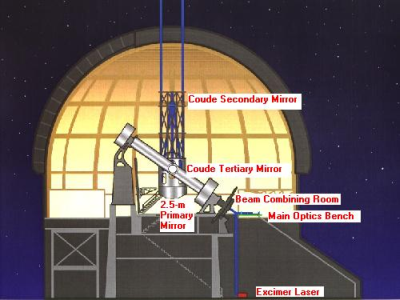
|
The acronym UnISIS is derived from
University of Illinois
Seeing Improvement
System.
Funded by the National Science Foundation: Astronomy Advanced Technologies and Instrumentation
UnISIS Subsystems
For general orientation purposes, please refer to the title-bar image above showing the 2.5-m Telescope in its dome.
Look for the labels: Main Optics Bench, Beam Combining Room, Excimer Laser. Then click on the
thumbnail images below to bring up a description of these UnISIS subsystems.
Once you click, you will also find links to close-up images of the individual components within
UnISIS: the deformable mirror, the tip-tilt mirror, beam transfer optics, etc.
| Main Optics Bench |
Beam Combining Room |
Excimer Laser |
Control Room |
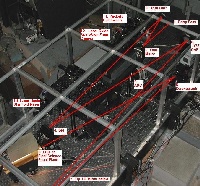 |
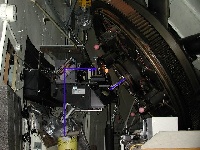 |
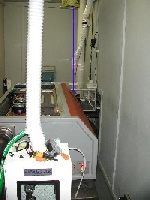 |
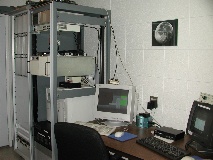 |
How Does the Performance of UnISIS Compare with that of other AO Systems in the U.S.?
The first 6 lines compare Natural Guide Star (NGS) capabilities only. The last 2 lines compare
Laser Guide Star (LGS) systems.
| Telescope AO System |
Operating Frequency |
Telescope Diameter |
Total No. Actuators |
Actuator Spacing in Pupil |
| UnISIS NGS / Mt. Wilson |
Maximum=1.3KHz Typical=600Hz |
2.5-m |
177 |
20 cm |
| Palomar AO |
Maximum=2 KHz Typical=500-800Hz |
5-m |
241 |
32 cm |
| Keck AO |
Maximum=500Hz |
10-m |
241 |
64 cm |
| Lick Observatroy |
Maximum=500Hz |
3-m |
61 (36 subapertures) |
44 cm |
| MMT |
Maximum=555Hz |
6.5-m |
336 (12x12 subapertures) |
54 cm |
| AEOS Telescope |
Maximum=200Hz Typical=50Hz |
3.67-m |
944 |
11 cm **Effective 17 cm |
|
|
|
|
|
| UnISIS LGS / Mt. Wilson |
Maximum=333Hz Typical=167Hz |
2.5-m |
177 |
20 cm |
| Lick LGS / Mt. Hamilton |
100-200Hz-at-zenith 55Hz-off-zenith |
3-m |
61 (36 subapertures) |
44 cm |
**Oppenheimer et al. 2004, Proc. SPIE, v. 5490, p. 433.
UnISIS Papers:
Click here for a list of published papers.
UnISIS Performance:
Click here for performance characteristics
of the AO system as well as a few images showing AO-on and AO-off.
UnISIS Credits
Click here for an early group picture of those who helped to build UnISIS.
Active Researchers:
Prof. Laird Thompson, Principal Investigator & Prof. of Astronomy, University of Illinois
Prof. Scott Teare, Co-Principal Investigator & Prof. of Electrical Engineering, New Mexico Tech
Associated Researchers:
Prof. Xiong Yao-Heng, Visiting Assistant Professor, University of Illinois
Permanent Position: Head of Laser Ranging, Yunnan Observatory, P.R.China
NIRIM - Near Infrared Camera:
Dr. Margaret Meixner - Formerly UIUC Astronomy, now STScI
EEV Wavefront Sensor Electronics & 2048x2048 Loral Sensor and Electronics:
Dr. Robert Leach - SDSU, Astronomy and Astronomical Research Cameras, Inc.
MIT/LL Wavefront Sensor Electronics (this camera is now retired):
Prof. Ray DuVarney - Emory University, Physics
Dr. Jim Beletic - Georgia Institute of Technology (now at Keck)
Optical Design Consultant:
Dr. E. Harvey Richardson - Dominion Astrophysical Observatory, Retired
Software Consultant:
Mr. Thomas Schneider - RipTideRealTime Inc., Topanga Canyon, CA.
Electrical Consultant:
Mr. Joseph Russell - De La Guerra Power, Inc.
Past Researchers:
Prof. Abhiit Chakraborty (now at Physical Research Laboratory, Ahmedabad, India)
Dr. Peter McCullough, Hubble Fellow & Assistant Professor - UIUC Astronomy (now STScI)
Mr. Richard Castle, Researcher - UIUC Astronomy (since retired)
Mr. Samuel Crawford, Graduate Student - UIUC Electrical & Computer Engineering (now at JPL)
Mr. Christopher Neyman, Graduate Student - UIUC Astronomy (now at KECK)
Ms. Jie Zou, Graduate Student - UIUC Astronomy (now Physics Department, Eastern Illinois University
Mr. Daniel Bullok, Graduate Student - UIUC Computer Science
Mr. Daniel Goscha, Undergraduate Student - UIUC Astronomy
Mr. Jeremy Hicks, Undergraduate Student - UIUC Engineering
Funding
The construction as well as science commissioning of UnISIS was administered by
Advanced Technologies and Instrumentation (ATI) Section in the Astronomy Program of the National Science
Foundation under award numbers AST-9220504 and AST-0096741.
ATI Program Directors who have been involved in overseeing the UnISIS development have included
Dr. G. Wayne van Citters, Dr. Benjamin Snavely, Dr. James Breckinridge, and Dr. Andrew Clegg. Additional
funding was provided by the University of Illinois College of Liberal Arts and Sciences and the University
of Illinois Astronomy Department. Any opinions, findings and conclusions or recommendations expressed in this
material are those of the author of this web page and do not necessarily reflect the views of the National
Science Foundation.
Last Updated: September 2, 2013




